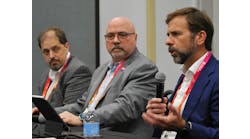Involve integrators early on new capacity projects
From the U.S. Infrastructure Investment and Jobs Act to the Rebuilding American Infrastructure with Sustainability and Equity (RAISE) program, hundreds of billions of dollars are being infused into the economy. And, as manufacturers prepare for increased demand in a digital age of data-rich production, greenfield and brownfield automation projects are continuing to take center stage to meet new capacity requirements.
“You’re building factories of the future, and none of that can happen without data and without security,” explained Brenden Lowe, Rockwell Automation’s sales and strategy transformation leader, who hosted three panels of original equipment manufacturers (OEMs), system integrators and engineering, procurement and construction (EPC) firms as part of the first New Capacity Summit during Automation Fair, hosted by Rockwell Automation, in Anaheim, California.
“The biggest challenge is the definition of the deliverable, the scope,” said Jack Uhl (left in photo), vice president, business development, Convergix Automation Solutions, a system integrator that comprises four business units ranging from automotive to food and beverage. The scope of the work can be as small as a stand-alone cell all the way up to an entire production line.
The best way to sidestep opportunities for scope creep is to engage a system integrator early, advised Chad McDowell (right in photo), technical resource director at Concept Systems, a Rockwell Automation gold-level integrator. “If you get the integrator involved earlier, as early as possible, they’re more likely to understand your goals,” he said. “In a large greenfield project, you’re going to use your own engineers. Get an integrator to help guide those RFQs [requests for quotation] to OEMs before you start to design the building.”
McDowell oversees the applications organization at Concept Systems, which uses Rockwell Automation’s FactoryTalk Optix to leverage artificial-intelligence (AI) tools, such as generative code design and object-oriented programming.
“It’s incumbent on us to become a more trusted environment,” explained Uhl. “A lot of it is the future growth—the flexibility and connectivity. Our four business units have a collaborative history of about 160 years.”
Two years ago, Convergix integrated a total greenfield plant with a tremendous amount of equipment. “Scope creep can occur,” warned Uhl. “You need to plan in order to mitigate it with product-management tools and understand what’s driving the changes. If you plan, it’s much easier to integrate than if you’re reactive.”
The global economy has driven factories to a more rapid speed-to-market acumen. “Our customers take a faster approach for how we engage with them,” explained Uhl. “The mitigation of risk is really important when you increase that velocity. We utilize digital design to provide value to our customers to maintain the cadence.”
Go to the source
Wunderlich-Malec (WM), a system integrator with offices across the United States built out manufacturing capacity in its own facilities several years ago, said Bill Storey, director of sales at WM, giving the integrator a firsthand view of what its customers are experiencing. “Clients need a single source to work with instead of multiple contractors,” he explained.
“It’s really about speed to market,” stressed Craig Pearce, director, sales and marketing, at QCA Systems. “In the ports, they’ve been pretty progressive,” he noted. “We are sole-sourced most of the time. Maybe our contract is $20 million, but we sit at the table early. We think about data flows. When I think of time to market, I think of ownership. You can’t hire an integrator later and expect them to pull it all together. Documents don’t enforce standards; people do. You can test everything ahead of time. You can prove everything. When you’re already in the field, it’s very expensive to do that.” QCA can shorten engineering by six months up to a year, said Pearce.
“We’re engineering-focused, but we’re very boots on the ground,” noted Storey. “Being part of a design-assist team puts us in a position where we can identify detailed things that are often overlooked. If we can get piping-and-instrumentation-diagram (P&ID) detail and all of the OEM interfaces mapped out in advance, when you get to the construction part of the process, it works out more smoothly. It helps us give faster deployment for our clients.”
It’s a change of mindset, added Scott Peterson, CEO of system integrator Interstates. “How can we help this project reach its potential? Traditionally, it’s trying to manage the cost and manage the scope. Manage, manage, manage. When you make decisions earlier, a year ahead of time, you have the commitment to do it, and it helps everyone understand it. The mindset needs to be to pick a team first—what’s the best team for the project?—and then work from that.”
New capacity isn’t always just greenfield. “It comes at us in many ways,” stressed Storey. Sometimes legacy capacity could have been installed 30 or 40 years ago. Updating PLC-5 controllers to ControlLogix control systems requires a bit of background and expertise that the factory or plant might not necessarily have on staff. “They’re often lacking the experience with these older technologies,” he mentioned. An integrator partner can supplement that expertise and be an important part of those types of brownfield capacity-expansion projects.
Interstates’ clients range from the Fortune 50 to smaller manufacturers. “They all have their own scope,” noted Peterson. “The key for us is the relationship. For a lot of large companies, they have their own system that you have to work within. You have to embrace it. We lean into it. The smaller firms need more guidance, so you often have more influence. Their careers are on the line because it’s often the largest project they’ve ever done.” Often, smaller companies will defer to what they see as the safest choice, which is often not the best choice, warned Peterson.
A lot of QCA’s customers in British Columbia have adopted an approach to early adoption to facilitate the integration of the most appropriate combination of technologies. “It’s more important to think about interoperability, but the system can be better than the sum of the parts if it’s well-integrated,” explained Pearce. “In British Columbia, we have not enough trades [people] or integration companies. Deciding on the team early on means the best talent, not the lowest price.”
More than just a financial commitment
Much like the OEM and system integrator panels, the EPC panel elicited similar advice on involvement early in the process.
“You’ve got to meet the clients where they are,” said Abhishek Sharda, director of strategic specialties, national automation lead, at Brown and Caldwell. “Our expectations are not limited to financials. It’s more of a cultural fit, so we can meet clients where they are—understand where they are and optimize the resources.”
CRB, another EPC firm, is seeing the same thing where projects are getting more complex earlier on. “It’s important to get the team together and built earlier, so they know the budget and what it’s going to take to get that project done,” agreed Jim Vortherms, senior director and general manager, control systems and integration business, at CRB.
“Over the past five to 10 years, we’ve certainly been asked to get to completion faster,” noted Adam Benjey, senior vice president, industrial construction, at Salas O’Brien. “The challenge is to help them get there with less. There is an opportunity, but the challenge is to get away from that traditional phase-gate model. Our partners need to have the same mindset of what success looks like.”
Clients need to know what they know and what they don’t know, advised Benjey. They must be willing to trust the partner to lead them. “A smaller client is looking for you to paint the picture and explain their options,” he said, noting a lot of end users also are leaner now than they used to be and don’t have the in-house knowledge they once did because of retirements and more compact staffs.
The most important factor for a successful project is committed resources from the customer, noted Vortherms. The dedicated team members from the client can’t be on the project as their second job, in addition to their regular duties. “A lot of companies we deal with don’t understand the process,” he warned.
Brown and Caldwell is seeing a lot of expansion in existing facilities. “Adoption of what works best for them is the biggest challenge,” stressed Sharda, who noted that the sales lifecycle begins much sooner than it did previously. “It starts much earlier. It can be as long as five years,” he noted. “That means bringing the contractors to the table right out of the gate.”
CRB is often asked how to build a plant of the future and get it ready for data. “We’ll start with the controls philosophy,” explained Vortherms. “What is the right footprint for that digitalization?”








